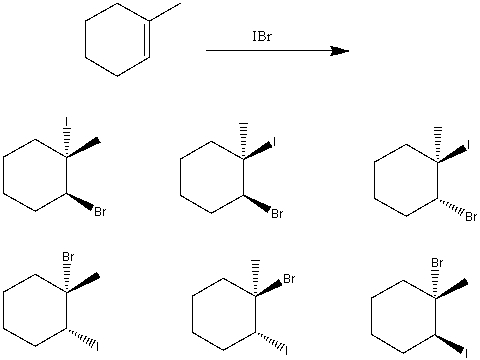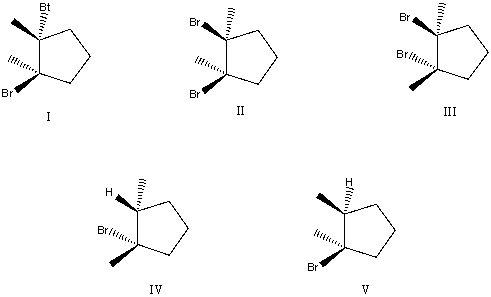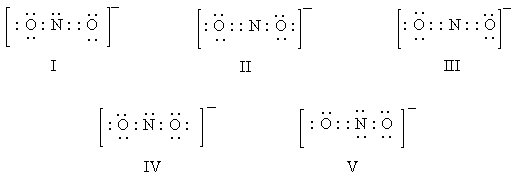A) ![]()
B) ![]()
C) ![]()
D) ![]()
E) ![]()
G) B) and E)
Correct Answer

verified
Correct Answer
verified
Multiple Choice
The conversion of ethylene to vinyl bromide can be accomplished by use of these reagents in the order indicated.
A) (1) HBr; (2) NaOC2H5
B) (1) Br2; (2) NaOC2H5
C) (1) Br2; (2) H2O
D) (1) NaNH2; (2) HBr
E) (1) HBr; (2) H2SO4
G) A) and B)
Correct Answer

verified
Correct Answer
verified
Multiple Choice
Which of these is not a possible product when cyclopentene reacts with an aqueous solution of bromine? 
A) I
B) II
C) III
D) IV
E) V
G) A) and D)
Correct Answer

verified
Correct Answer
verified
Multiple Choice
What is the major product of the following reaction sequence? 
A) ![]()
B) ![]()
C) ![]()
D) ![]()
E) None of these choices.
G) A) and E)
Correct Answer

verified
Correct Answer
verified
Multiple Choice
What is the major product for the following reaction? 
A) ![]()
B) ![]()
C) ![]()
D) ![]()
E) None of these choices.
G) All of the above
Correct Answer

verified
Correct Answer
verified
Multiple Choice
How many of the products shown below are possible in the following reaction? 
A) 1
B) 2
C) 4
D) All of them.
E) None of them.
G) B) and E)
Correct Answer

verified
Correct Answer
verified
Short Answer
The introduction of a small amount of a peroxide to a hydrogen halide addition of an alkene will result in a(n)___ addition where the hydrogen in the addition appears adds to the carbon with the ___ number of hydrogens.
Correct Answer

verified
anti-Marko...View Answer
Show Answer
Correct Answer
verified
View Answer
Short Answer
bonds are quite susceptible to reaction with electron-seeking reagents,also referred to as ___.
Correct Answer

verified
Correct Answer
verified
Multiple Choice
An unknown compound,A,has the molecular formula C7H12.On oxidation with hot aqueous potassium permanganate,A yields CH3CH2COOH and (CH3) 2CHCOOH.Which of the following structures best represents A?
A) ![]()
B) ![]()
C) ![]()
D) ![]()
E) ![]()
G) C) and D)
Correct Answer

verified
Correct Answer
verified
Multiple Choice
What are the major product(s) formed by treating 1,2-dimethyl cyclopentene with Br2? 
A) I,II
B) II,III
C) IV,V
D) I,III
E) None of these choices.
G) C) and D)
Correct Answer

verified
Correct Answer
verified
Essay
Predict the product(s)of the oxidation of 2,3,4-trimethyl-1,5-heptadiene with hot,alkaline KMnO4.
Correct Answer

verified
Correct Answer
verified
Multiple Choice
Ozonolysis of compound Z yields the products shown below.What is the structure of Z? 
A) I
B) II
C) III
D) IV
E) V
G) A) and C)
Correct Answer

verified
Correct Answer
verified
Multiple Choice
What is the chief product of the acid-catalyzed hydration of 2,5-dimethyl-2-hexene?
A) 2,5-dimethyl-1-hexanol
B) 2,5-dimethyl-2-hexanol
C) 2,5-dimethyl-3-hexanol
D) 2,5-dimethyl-2,3-hexanediol
E) 2,5-dimethyl-3,4-hexanediol
G) C) and D)
Correct Answer

verified
Correct Answer
verified
Multiple Choice
What is the major product for the following reaction? 
A) ![]()
B) ![]()
C) ![]()
D) ![]()
E) None of these choices.
G) None of the above
Correct Answer

verified
Correct Answer
verified
Multiple Choice
Treating 1-methylcyclohexene with HCl would yield primarily which of these? 
A) I
B) II
C) III
D) IV
E) V
G) B) and C)
Correct Answer

verified
Correct Answer
verified
Multiple Choice
What is the major product of the following reaction sequence? 
A) ![]()
B) ![]()
C) ![]()
D) ![]()
E) ![]()
G) B) and E)
Correct Answer

verified
Correct Answer
verified
Multiple Choice
What is the major product for the following reaction? 
A) ![]()
B) ![]()
C) ![]()
D) ![]()
E) ![]()
G) All of the above
Correct Answer

verified
Correct Answer
verified
Multiple Choice
A reagent or test that could be used to distinguish between 1-pentene and 1-pentyne would be:
A) Bromine in carbon tetrachloride
B) Dilute aqueous potassium permanganate
C) Chlorine in carbon tetrachloride
D) H2SO4
E) IR examination
G) B) and D)
Correct Answer

verified
Correct Answer
verified
Essay
Give a mechanistic explanation for the formation of the following product in significant yield.What other product(s)might also be obtained? Explain clearly. 
Correct Answer

verified
 The regioselective addition of a proton...
The regioselective addition of a proton...View Answer
Show Answer
Correct Answer
verified
View Answer
Essay
Deduce the structure of an unknown compound A,C8H14,from the following data.Briefly,but clearly explain your rationale.A decolorizes Br2/CCl4,and upon reaction with excess H2/Ni,affords 1-ethyl-2-methylcyclopentane.When A is subjected to ozonolysis,the following product is obtained. 
Correct Answer

verified
A must be 3-ethyl-4-...View Answer
Show Answer
Correct Answer
verified
View Answer
Showing 121 - 140 of 163
Related Exams